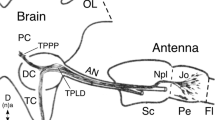Summary
The fine structure of the superposition eye of the Saturniid moth Antheraea polyphemus Cramer was investigated by electron microscopy. Each of the approximately 10000 ommatidia consists of the same structural components, but regarding the arrangement of the ommatidia and the rhabdom structure therein, two regions of the eye have to be distinguished. In a small dorsal rim area, the ommatidia are characterized by rectangularly shaped rhabdoms containing parallel microvilli arranged in groups that are oriented perpendicular to each other. In all other ommatidia, the proximal parts of the rhabdoms show radially arranged microvilli, whereas the distal parts may reveal different patterns, frequently with microvilli in two directions or sometimes even in one direction. Moreover, the microvilli of all distal cells are arranged in parallel to meridians of the eyes. By virtue of these structural features the eyes should enable this moth not only discrimination of the plane of polarized light but also skylight-orientation via the polarization pattern, depending on moon position. The receptor cells exhibit only small alterations during daylight within the natural diurnal cycle. However, under illumination with different monochromatic lights of physiological intensity, receptor cells can be unbalanced: Changes in ultrastructure of the rhabdomeres and the cytoplasm of such cells are evident. The effects are different in the daytime and at night. These findings are discussed in relation to the breakdown and regeneration of microvilli and the influence of the diurnal cycle. They are compared with results on photoreceptor membrane turnover in eyes of other arthropod species.
Similar content being viewed by others
References
Aepli F, Labhardt T, Meyer E (1985) Structural specializations of the cornea and retina at the dorsal rim of the compound eye in hymenopteran insects. Cell Tissue Res 239:19–24
Bennett RR (1983) Circadian rhythm of visual sensitivity in Manduca sexta and its development from an ultradian rhythm. J Comp Physiol 150:165–174
Blest AD (1980) Photoreceptor membrane turnover in arthropods: Comparative studies of breakdown processes and their implications. In: Williams TP, Baker BN (eds) The effect of constant light on visual processes. Plenum Press, New York pp 217–245
Blest AD, Kao L, Powell K (1978) Photoreceptor membrane break-down in the spider Dinopis: The fate of the rhabdomere products. Cell Tissue Res 195:425–444
Blest AD, Stowe S, Eddey W, Williams D (1982) The local deletions of a microvillar cytoskeleton from photoreceptors of tipulid flies during membrane turnover. Proc R Soc Lond [Biol] 215:469–479
Burghause, F (1979) Die strukturelle Spezialisierung des dorsalen Augenteils der Grillen (Orthoptera, Grylloidae). Zool Jahrb Physiol 83:502–525
Chamberlain ST, Barlow R jr (1984) Transient membrane shedding in Limulus photoreceptors: Control mechanisms under natural lighting. J Neurosci 4 (11):2792–2810
Chi C, Carlson SD, Ste Marie R (1979) Membrane specializations in the peripheral retina of the housefly Musca domestica L. Cell Tissue Res 198:501–520
Egelhaaf A, Dambach M (1983) Giant rhabdoms in a specialized region of the compound eye of a cricket: Cycloptiloides canariensis (Insecta, Grylloidae). Zoomorphology 102:65–77
Eguchi E (1982) Retinular fine structure in compound eyes of diurnal and nocturnal sphingid moths. Cell Tissue Res 223:29–42
Eguchi E, Waterman T (1967) Changes in retinal fine structure induced in the crab Libinia by light and dark adaptation. Z Zellforsch 79:209–229
Fischer A, Horstmann G (1970) Der Feinbau des Auges der Mehlmotte Ephestia kuehniella Zeller (Lepidoptera, Pyralididae). Z Zellforsch 116:275–304
Lane N (1982) Insect intercellular junctions: Structure and Development. In: King RC, Akai H (eds) Insect Ultrastructure, vol. 1, Plenum Press, New York, pp 402–433
Langer H, Schmeinck G, Anton-Erxleben F (1986) Identification and localization of visual pigments in the retina of the moth, Antheraea polyphemus (Insecta, Saturniidae). Cell Tissue Res 245:81–89
Meinecke CC (1981) The fine structure of the compound eye of the African armyworm moth, Spodoptera exempta (Insecta, Noctuidae). Cell Tissue Res 216:233–247
Meinecke CC, Langer H (1982) Structural reactions to polarized light of microvilli in photoreceptor cells of the moth Spodoptera. Cell Tissue Res 226:225–229
Meinecke CC, Langer H (1984) Localization of visual pigments within the rhabdoms of the compound eye of Spodoptera exempta (Insecta, Noctuidae). Cell Tissue Res 238:359–368
Odselius R, Elofsson R (1981) The basement membrane of the insect and crustacean compound eye: Definition, fine structure, and comparative morphology. Cell Tissue Res 216:205–214
Schwemer J (1985) Turnover of photoreceptor membrane and visual pigment in invertebrates. In: Stieve H (ed) The molecular mechanisms of photoreception. Dahlem Konferenzen. Springer, Berlin Heidelberg New York Tokyo pp 303–326
Shaw SR (1977) Restricted diffusion and extracellular space in the insect retina. J Comp Physiol 113:257–288
Spurr AR (1969) A low-viscosity epoxy resin embedding medium for electron microscopy. J Ultrastruct Res 26:31–43
Stowe S (1980) Rapid synthesis of photoreceptor membrane and assembly of new microvilli in a crab at dusk. Cell Tissue Res 211:419–440
Stowe S (1983) Phagocytosis of rhabdomeral membrane by crab photoreceptors (Leptograpsus variegatus). Cell Tissue Res 234:463–467
Venable JH, Coggeshall R (1965) A simplified lead citrate stain for use in electron microscopy. J Cell Biol 25:407–408
Waterman TH (1982) Fine structure and turnover of photoreceptor membranes. In: Westfall JA (ed) Visual cells in evolution. Raven Press, New York pp 23–41
Wehner R (1982) Himmelsnavigation bei Insekten. Neurophysiologie und Verhalten. Neujahrsblatt Naturforsch Ges Zürich 126: Heft 5
Welsch B (1977) Ultrastruktur und funktionelle Morphologie der Augen des Nachtfalters Deilephila elpenor (Lepidoptera, Sphingidae). Cytobiologie 14:378–400
White RH, Walther JD (1969) The leech photoreceptor cell: Ultrastructure of clefts connecting the phaosome with extracellular space demonstrated by lanthanum deposition. Z Zellforsch 95:102–108
Williams D (1982) Ommatidial structure in relation to turnover of photoreceptor membrane in the locust. Cell Tissue Res 225:595–617
Author information
Authors and Affiliations
Rights and permissions
About this article
Cite this article
Anton-Erxleben, F., Langer, H. Functional morphology of the ommatidia in the compound eye of the moth, Antheraea polyphemus (Insecta, Saturniidae). Cell Tissue Res. 252, 385–396 (1988). https://doi.org/10.1007/BF00214381
Accepted:
Issue Date:
DOI: https://doi.org/10.1007/BF00214381




